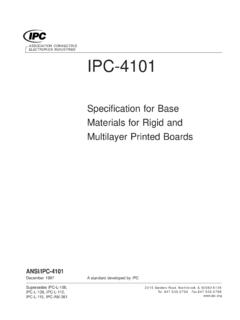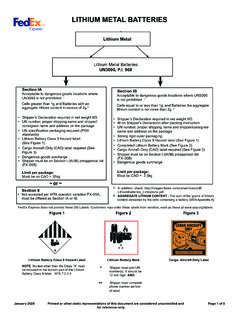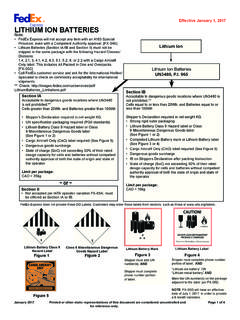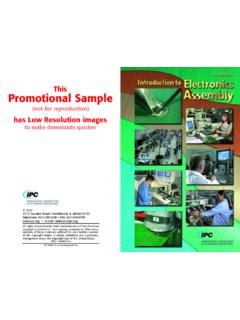Transcription of SURFACE FINISHING FOR PRINTED CIRCUIT BOARDS
1 SURFACE FINISHINGFORPRINTED CIRCUIT BOARDSIn a world of ever-increasing electronic component complexity and pin count requirements forcomponent packaging, focus is once again on the age-old question of "How do we preserve solderablesurfaces between PWB manufacturing and assembly?" PCB manufacturers today are faced with thedecision of which SURFACE finish to offer their customers, while their customers struggle with choosing thebest SURFACE coating for their application. Ultimately, the SURFACE coating choice belongs to the end user,or customer, not the PCB manufacturer. This article will discuss the various SURFACE coatings andcharacteristics of variables that must be considered when choosing the best SURFACE finish are too numerous to listhere.
2 The following are the most common process variables of concern at assembly: Component type and placement method Solder paste type and application (if applicable) Fusing method Possible exposure of each board type to a variety of assembly processes Multiple thermal exposures Post cleaning (if applicable)Less common considerations include the elimination of CFCs and the possible exclusion of leadedsolders, solder paste, and flux at # HAL-Finishes-005 REV -- -2-Choices for solderable finishes include organic solderability preservatives (OSPs), immersion,electrolytic and electroless nickel/gold, and fused or hot air leveled solder. Solder has traditionally beenthe preferred are available in many forms and would clearly be the finish of choice if the decision were the soleresponsibility of the PCB manufacturer.
3 The application of an organic SURFACE finish is easy to apply andcost effective. It also eliminates the need for lead-bearing solders in one PCB manufacturing may work well in some assembly processes that do not require extended shelf life prior toassembly and are not exposed to multiple fusing cycles. It is generally agreed that OSP coatings requirespecial handling to retain solderability over a period of , there are several concerning issues involved with the use of OSPs. When using an organiccoating, the solderability of the PCB is not proven until the assembly process. SURFACE contaminatessuch as tin left behind in the solder or tin stripping process, copper oxides, soldermask residues, andeven clean copper surfaces brightened with excessive organic plating additives can leave a PCBunsolderable.
4 OSPs can be applied over any of these conditions which will not be highlighted until theboard fails at assembly. At this stage, rework is very costly since components are now fluxes, which should be dominant in the near future, present another potential problem for theOSPs. They are often incompatible with no-clean fluxes. In many cases, these fluxes are not capableof penetrating the organic SURFACE to activate and create a solderable condition. OSP coatings aredesigned to be a barrier to corrosion and copper oxide. They are removed or broken down by acidsand heat. Low acid aqueous-based no-clean fluxes are what typical OSPs are designed to are many issues that present themselves when OSP coatings are used with the new, lessaggressive no-clean fluxes.
5 These obstacles emerge in many forms, from exposed copper to insufficientsolder wetting and hole fill (Reference Figure 1). The new formulations that indicate better wettingresults are very expensive and have very tight process windows within which PH levels must be thickness of the coating can also have a negative effect on the board 's ability to be electricallytested. If the coating is too thick, it can interfere with the continuity between a test probe and the pointbeing are being used in several applications with varying degrees of success. It is interesting that age-old criteria for PCB reliability has been altered for OSP acceptability. Shelf life, coverage and through-hole fill are just a few of these changes. Evaluations have shown exposed copper and incomplete holefill at wave solder.
6 These have been explained away as insignificant even if such defects are cause forDOC# HAL-Finishes-005 REV -- -3-rejection on a HAL-soldered PCB. The conclusions of these evaluations state that OSPs areacceptable for the application, and there is no significant difference when compared to other coatings(Reference Figures 1, 2, and 6).A nickel/gold finish offers solutions to some of the shortcomings of the OSPs. Electrical test is notimpaired by the presence of nickel/gold. The gold finish is easily activated by mild fluxes, which makesthis finish more compatible with the no-clean fluxes. A nickel/gold finish is capable of withstandingnumerous assembly operations with no degradation of the board 's solderability.
7 In spite of theseadvantages, like the OSPs, there are performance issues which limit the effectiveness of the , gold is a contaminate of solder. While it is true that a "thin enough" coating of gold absorbed intoa "thick enough" deposit of solder paste will probably not effect the quality of the solder joints, theprocess tolerances in both the gold and solder paste application process are allowed very little concentrations below in solder do not show any problems. The shear strength is slightlyinfluenced by the gold at these concentrations and considered acceptable. It is recommended that thegold concentration be kept below to prevent brittle and fractured joints. Gold-tin intermetallicformed on the SURFACE of copper-rich alloys reduces the low fatigue life of the joints drastically.
8 Goldconcentrations over result in many voids in the solder joint. Like the OSPs, electrolessnickel/gold can be applied over a contaminated SURFACE , which can cause solder joint nickel/gold is an expensive process and generally time consuming. Electrolytic nickel withelectroless gold is the more expensive nickel/gold nickel/gold and OSPs cannot perform in assembly processes where the pre-soldered, HAL circuitboard is required to carry the full volume of solder necessary to make the solder joint, such as hot barsoldering and some TAB assembly processes. Nickel/gold does work well with the more expensivewire bonding nickel/gold and OSPs require the same bond to occur at assembly. This allows the solder paste tomelt and sizzle prior to pad wetting.
9 The time required to wet a solder joint allows for increased solderball production at solder is, and always will be, the best finish to use when fusing to solder paste or to itself. Solder hasthe shortest wetting times at assembly and requires the least amount of activation from assembly fluxes,which makes it the most compatible with no-clean assembly processes. When evaluating HALcapability, it is useful to remember there is a difference between vertical and horizontal # HAL-Finishes-005 REV -- -4-The most globally used process is hot air solder leveling (HAL). For years, PWB component padshave been coated with solder using HAL. This coating provides excellent shelf life, high mechanicaldurability, and the shortest solder wetting time at assembly.
10 It is also a fact that an intermetallic (IMC)bond is formed before the PWB assembly process, and maintains solderability through multiple reflowand wave soldering cycles (Reference Figure 6-8).While the HAL process is affected by the same copper cleanliness issues as OSPs and nickel/gold, theeffects are found in the PCB manufacturing process, not at assembly. The formation of the copperintermetallic at horizontal HAL assures that the PCB is solderable prior to HAL process has come under fire recently as assemblers, driven to finer pitch SMT devices,require "flatter" pads. It is alleged that the dome shape of HAL pads can present a serious challenge tothe stencil printing operation used to deposit solder paste on the BOARDS for assembly, especially in finepitch nature of the HAL process is to create a mound of solder on the SMD pads.




